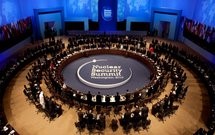 In just a few days, heads of governments of about four dozen nations would assemble in the Hague, Netherlands, for the third Nuclear Security Summit. An initiative started by President Obama in 2010 in Washington, the Summit travelled to Seoul in 2012 and Obama will host the next one again in 2016. What is the significance of this Summit process and has it been of any specific benefit to India?
In just a few days, heads of governments of about four dozen nations would assemble in the Hague, Netherlands, for the third Nuclear Security Summit. An initiative started by President Obama in 2010 in Washington, the Summit travelled to Seoul in 2012 and Obama will host the next one again in 2016. What is the significance of this Summit process and has it been of any specific benefit to India?
The most important gain from these Summits is that they have brought global attention to nuclear terrorism. President Obama initiated the effort after having realized that the risk of nuclear terrorism was real and urgent. However, India’s experience with cross-border terrorism well predates the US awakening to the threat. Since the end of 1990s, India has faced terrorism, sponsored and executed from Pakistan. Obviously, the threat of nuclear terrorism has been of utmost concern given that nuclear weapons (and an increasing stockpile of highly enriched uranium and plutonium) and terrorism co-exist in Pakistan.
Given this threat perception, a Summit process that demands national action and responsibility for securing nuclear and radiological materials has universalized a threat that India was fighting a lonely battle against. Attention to these issues at the highest political level has ensured their inclusion in national priorities and the accordance of necessary resources to turn commitments into reality. Heads of governments at the Summits have individually and collectively committed to taking measures to secure nuclear material on their territory according to accepted international benchmarks.
Amongst the international agreements that are relevant to this subject, two are worthy of mention. The Convention on Physical Protection of Nuclear Material (CPPNM) was crafted to regulate international transportation of nuclear material. It came into force in 1987. However, through an amendment in 2005, its ambit was expanded to protection of nuclear material in domestic use, storage and transport too. It enhanced mechanisms for cooperation to locate and recover stolen/smuggled nuclear material and to mitigate radiological consequences of sabotage. However, the amendment is not yet operative since it awaits ratification by 2/3d of the member states. The other instrument, the International Convention on Suppression of Acts of Nuclear Terrorism (ICSANT), meanwhile, came into force in 2007 mandating national laws for imposition of punitive action on those involved in nuclear terrorism. Unfortunately, neither of these instruments is universal and in fact, many of the countries that are known to harbor terrorists have not joined in, including Pakistan. However, the presence of political leaders at the Summit does exert political and moral pressure on outliers. Indeed, the number of countries joining the two Conventions has increased over the last six years, and a few more are expected to bring their decision to join in as a ‘house gift’ in 2014 too.
Some positive results notwithstanding, the Summit process does suffer from the shortcoming that it cannot impose uniformity in recognition of threat, or the same rigour in implementation of national efforts. Nations do perceive the threat differently. In any case, there is no punishment for non-compliance and many smaller nations have railed against the increase in need for reporting as burdensome and distracting from other national priorities.
In order to maintain the momentum on nuclear security and get nations to recognize the enormity of the risk, and hence the responsibility they share, it is necessary that a sense of stake-hood be felt by all. One way of doing so would be to foster greater sharing in two dimensions. The first would be information on best practices, for instance, on how countries practice enforcement such as training of security guards, crafting of personnel reliability programmes, tools used for data storage and mining, including on tracking of orphaned radiological sources, etc. The second would be the sharing of technologies, for instance, on manufacture of detection equipment such as scanners at ports, decontamination materials, medical countermeasures etc. Transfer of such technologies to countries where these could be manufactured at relatively lesser cost would not only make the manufacturing hubs a stakeholder in nuclear security but also make the detection equipment available at low prices thereby relieving nations of burdensome expenditure to deploy expensive machinery or systems.
Nuclear security is not the requirement or demand of one nation. The fact that a country as militarily capable as the USA has felt the need for collective effort in this direction proves that it is a shared risk and hence a shared responsibility that must be carried by all if we are to minimize, if not obviate, an unfortunate act of nuclear terrorism. India’s participation in the Nuclear Security Summit is indeed an opportunity to seek a collective redressal of a threat it faces, and also a contribution to international security – a win-win proposition either way.
By Special Arrangement with Institute of Peace and Conflict Studies (http://www.ipcs.org)